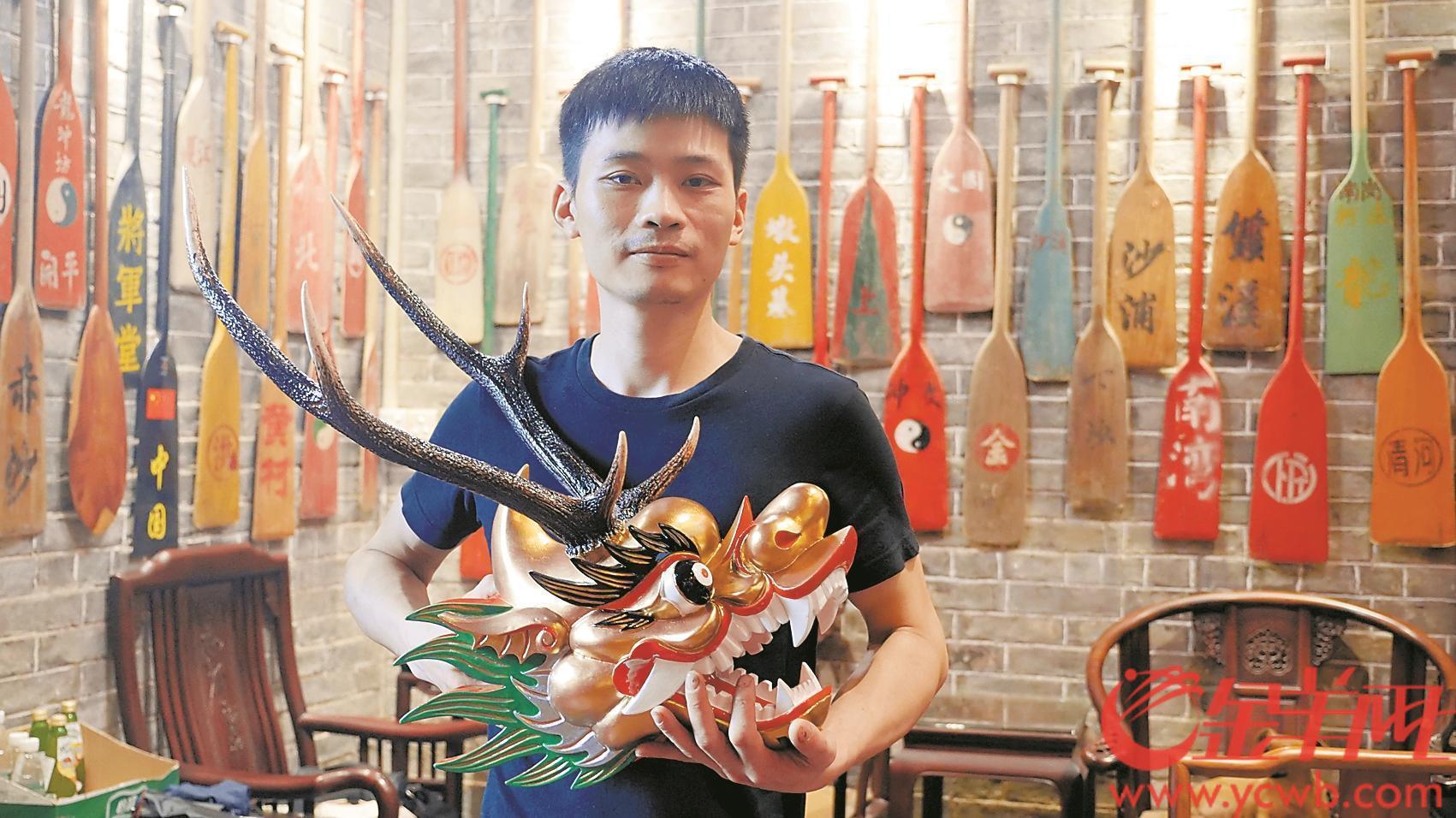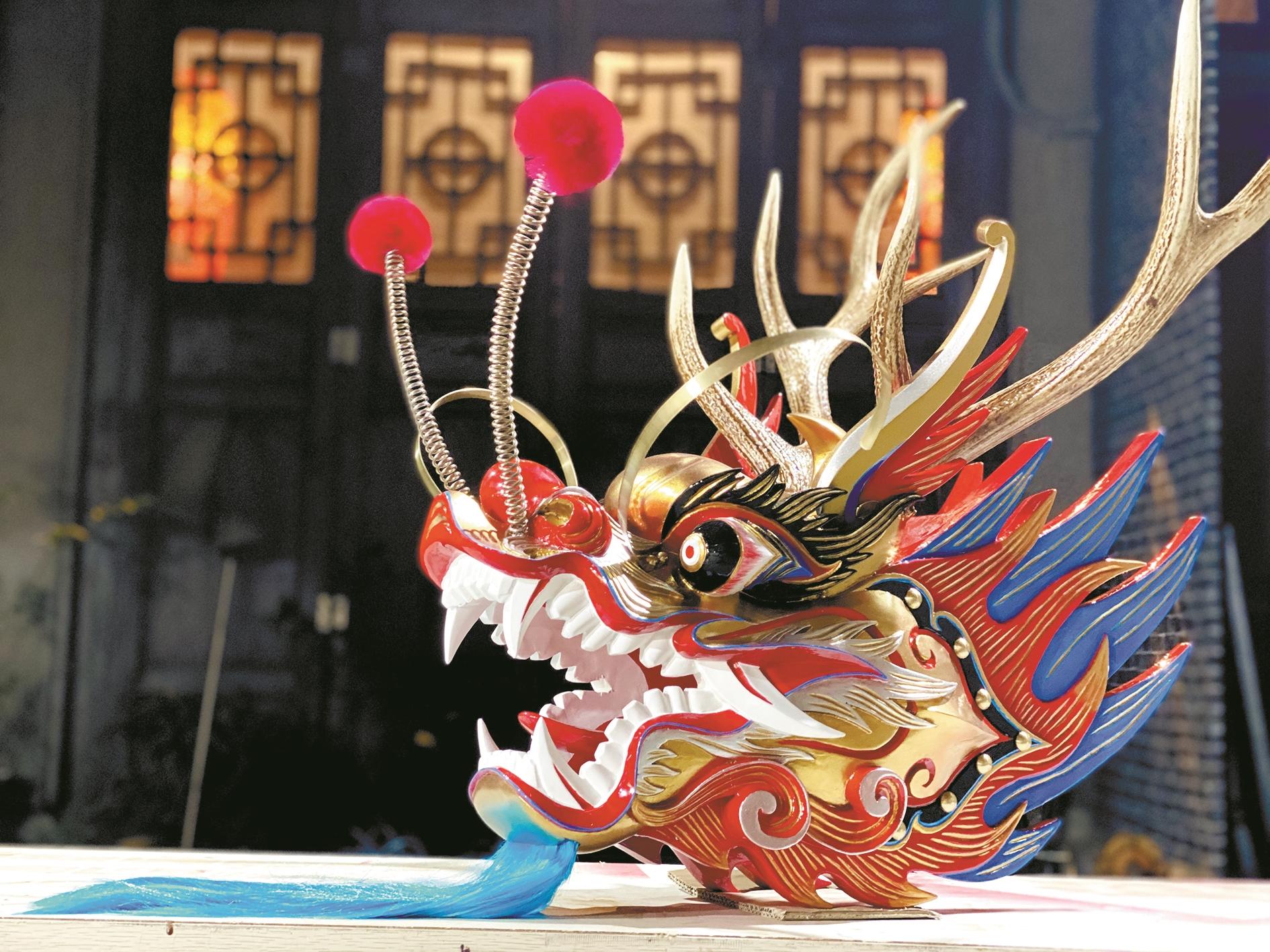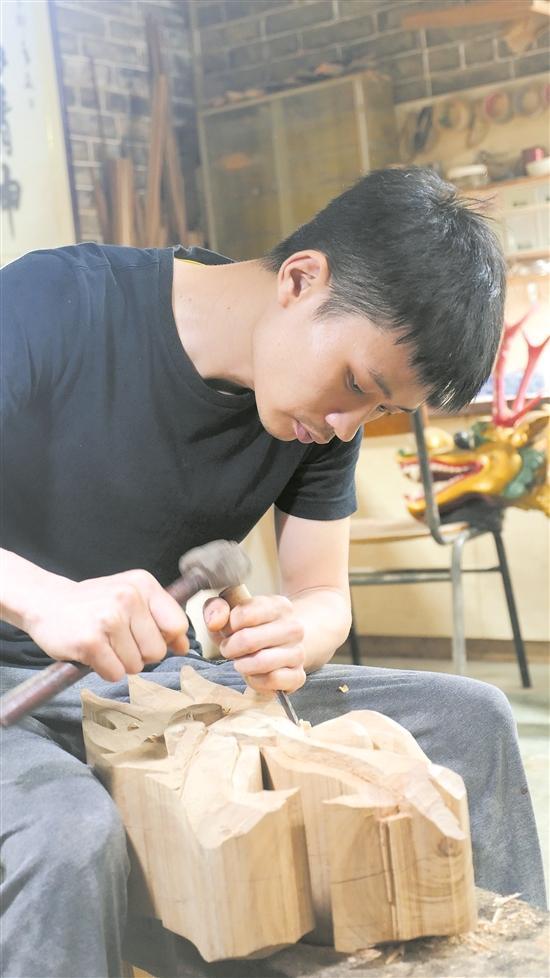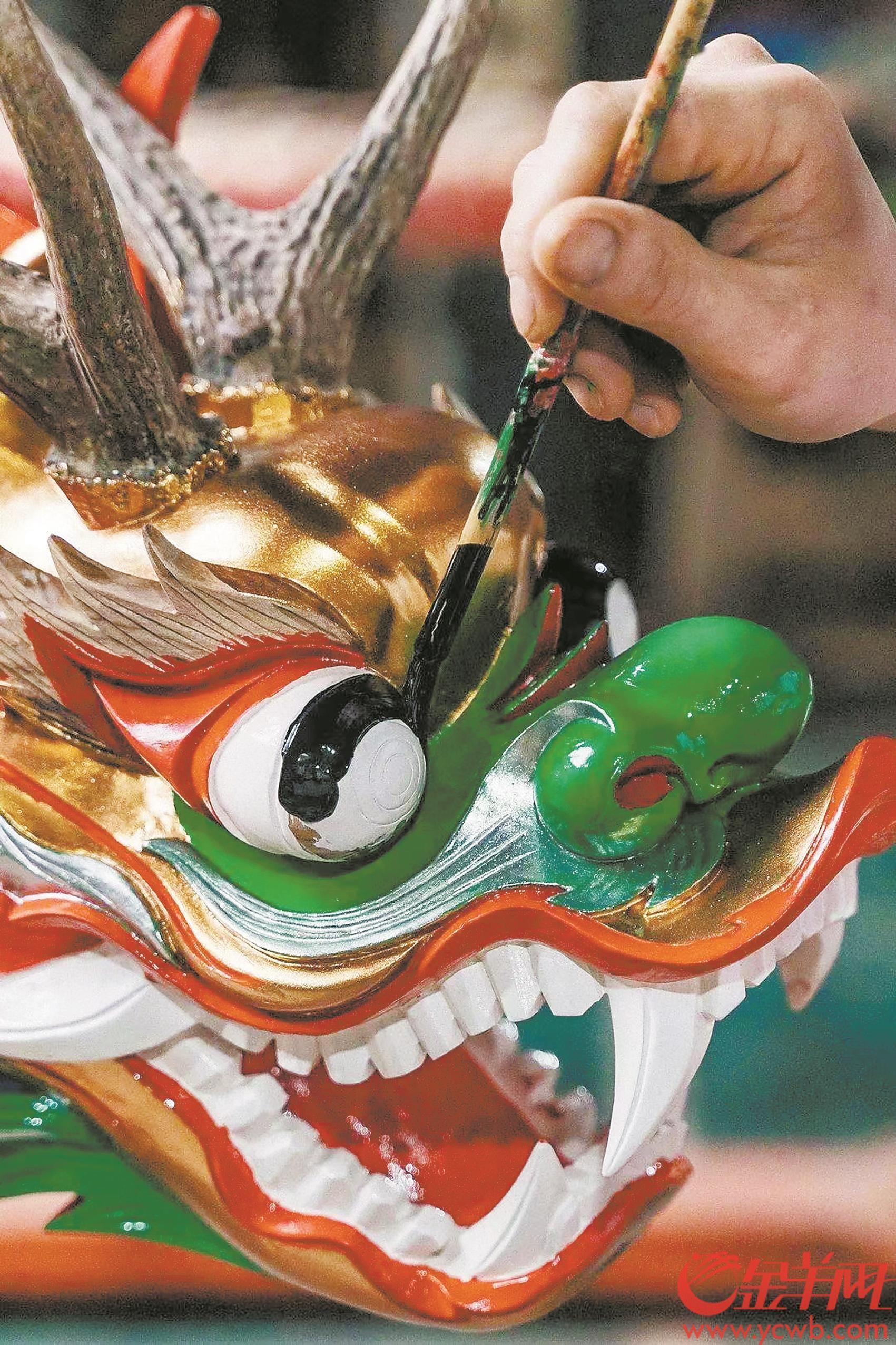Since ancient times, Lingnan has had the custom of “committing friends with dragons”. “Picking dragon boats” on the Dragon Boat Festival is not only a traditional folk activity, but also an important ceremony for people to visit relatives and friends. The dragon head is regarded as the “soul” of the dragon boat. It is a detachable independent component. It has different shapes and unique charms. It gives each dragon boat team a unique meaning. At the same time, the dragon head is vigorous and beautifully carved, and has become the object of people’s focus.
A craftsmanship, a craft, and a perseverance. They use a dragon boat bow to carve traditions, and also carve the spirit of craftsmanship and life.
 Zhang Weichao has carved dragon boats with dragon heads and tails for more than 20 years. Liu Zhuonan. Photo by Liu Zhuonan. The “leader” who appeared at the Winter Olympics comes from this “post-80s” in Guangzhou
Zhang Weichao has carved dragon boats with dragon heads and tails for more than 20 years. Liu Zhuonan. Photo by Liu Zhuonan. The “leader” who appeared at the Winter Olympics comes from this “post-80s” in Guangzhou
Yangcheng Evening News All-Media Reporter Liu Zhuonan Guo Siqi
In Xiasha Village, Huangpu District, Guangzhou, there is a special ancient ancestral hall. When you walk in, you can see that the blue brick wall is full of oars for dragon boats. On the other side, exquisite dragon heads are arranged in a scattered manner, with longan eyes wide open, elegant beards and domineering. Walking further, I saw a wide variety of woodcarving tools such as planers, chisels, saws, files, etc. on the ground. Wood chips floated in the air, and the sounds of machines and knocking sounds came one after another. This is Zhang Weichao’s dragon boat carving studio.
Zhang Weichao is a “post-80s”. He has been carving dragon boats with dragon heads and tails for more than 20 years. At the opening ceremony of this year’s Beijing Winter Olympics, in the countdown session set by 24 solar terms, a leading leader with Chinese characteristics that has a very traditional Chinese Babaylan surfaced with water splashes. This is Zhang Weichao’s leading work. From his childhood “playing around” to now moving to the world stage, Zhang Weichao has grown into a well-known dragon boat dragon head and tail carving craftsman in Guangdong, and is also the inheritor of the intangible cultural heritage of this project. He said: “Behind the dragon boat and dragon head skills is our folk culture, our roots and soul.”
 Zhang Weichao’s leading work Photo provided by the interviewee
Zhang Weichao’s leading work Photo provided by the interviewee
From the origin:
“Dragon boat is the most important cultural mark in my childhood”
Talking about its origin with the dragon boat, Zhang WeichaoCinema said that this was the most important cultural mark in his childhood. “Since I was a child, I loved watching dragon boat racing in the village. Children would make some small toys by themselves, and the small dragon boat model is one of them. “Zhang Weichao’s father was an old carpenter with a complete range of woodcarving tools at home. He also learned some carving skills, coupled with his interest and talent, and became the “ceiling” of carving dragon boats among his childhood playmates. When he was 12 years old, Zhang Weichao sold his first dragon boat model. When he was in junior high school, people from other villages asked him to customize and buy it. Gradually, Zhang Weichao became famous. He was still in school at that time and could only use his vacation to work. A model often took a summer vacation. In order to understand the shape of dragon boats in a more variety, the Dragon Boat Festival is here. href=”https://funnybookish.com/”>Cinema, Zhang Weichao took a ruler and a picture book to look at the dragon boats in the surrounding villages and record the data. At other times outside the noon festival, the dragon boats were sunk under the surging water, and Zhang Weichao often dived to understand the shape of the dragon boat. “At that time, it seemed like he had entered another small world. He liked these things and wanted to study them. My own works have been recognized and I am particularly proud. “Zhang Weichao said.
 Zhang Weichao is carving the dragon head Liu Zhuonan Photo
Zhang Weichao is carving the dragon head Liu Zhuonan Photo
Turn:
Resigned from the “iron rice bowl” and full-time carving the “head”
2009 was a turning point for Zhang Weichao. At that time, he graduated from the auto repair major of vocational school and had been staying at the school as a practical teacher for more than a year. It is difficult to take into account both teaching and carving career, so he decided to resign and concentrate on dragon boat carving. “It would seem like the whole world was opposing it.” At that time, there were only six or seven dragon boat production factories in Guangzhou, and there were only a handful of craftsmen who were full of hand-carved dragon boat dragon heads, and most of them were over 50 years old. Zhang Weichao, 22, made this choice, which was “very crazy” in many people’s eyes. But soon, he proved that Cinema understood himself.
One month before the Dragon Boat Festival in 2010, Zhang Weichao received a difficult order, and Luntou Village, Haizhu District urgently needed to become three new leaders. He had never carved a dragon head before, and he had to make three dragon heads in a month, and he was unsure. “The dragon head is the ‘soul’ of the dragon boat and an important symbol of a village. They trust me and I will do it no matter what.” For this reason, Zhang Weichao worked day and night at home, and finally handed over three exquisite dragon heads on time. At that time, the news spread all of a sudden, and many people rushed to watch after hearing the news, “They were all surprised that I, who made the dragon boat model, actually made three dragon leaders.” This also ushered in a turning point in his career – from dragon boat model carving to dragon head carving, he also became a well-known industry star, with orders coming one after another.
Caring a faucet is a very meticulous and complex task. Zhang Weichao introduced that handmade faucets require more than ten tedious processes such as wood selection, cutting materials, outlining, carving, polishing, and lacquer mounting. The cycle of completing a leading role can be as short as one week and as long as ten or twenty days, but the early work of Komiks often takes several months or even years.
“Every time I receive an order, the first thing I have to do is not carve, but go to the site to inspect and understand the history and culture of the village. I will let the villagers participate, especially the young people, and ask them to come up with some ideas for making the dragon head and make it based on their opinions. A dragon boat dragon head may take decades or hundreds of years. While the villagers participate in the production, they also understand their own village history and culture and increase their cultural pride. Such a dragon head is particularly warm and has a story.” Zhang Weichao said.
 ZhangWeichao is carving the dragon head, Liu Zhuonan. Inheritance: Finding the cultural roots behind the dragon boat head. In 2020, the “Dragon Boat Dragon Head and Dragon Tail Production Technique” was successfully applied for World Heritage. Zhang Weichao became the inheritor of this intangible cultural heritage project. Zhang Weichao’s mentality has changed from a craftsman to a inheritor of intangible cultural heritage. “In the past, I was a craftsman, and I thought about how to be a leader and do my job well. But now I have more responsibility and responsibility. Intangible cultural heritage is a very precious and relatively rare thing. It may be a slowly disappearing culture. When we protect it, we just want to disappear. KomiksSlower and slower. It is a very honor to be able to shoulder the inheritance of this historical and cultural heritage, and the responsibility is huge.”
ZhangWeichao is carving the dragon head, Liu Zhuonan. Inheritance: Finding the cultural roots behind the dragon boat head. In 2020, the “Dragon Boat Dragon Head and Dragon Tail Production Technique” was successfully applied for World Heritage. Zhang Weichao became the inheritor of this intangible cultural heritage project. Zhang Weichao’s mentality has changed from a craftsman to a inheritor of intangible cultural heritage. “In the past, I was a craftsman, and I thought about how to be a leader and do my job well. But now I have more responsibility and responsibility. Intangible cultural heritage is a very precious and relatively rare thing. It may be a slowly disappearing culture. When we protect it, we just want to disappear. KomiksSlower and slower. It is a very honor to be able to shoulder the inheritance of this historical and cultural heritage, and the responsibility is huge.”
Now Zhang Weichao often appears on major campuses and intangible cultural heritage inheritance activities. When teaching courses in school, Zhang Weichao not only taught students how to carve, but more importantly, let children understand the dragon boat and the cultural significance behind it. “Dragon boat skills cannot be learned at once, but they must become interested in dragon boats. Cultivating their recognition of Chinese traditional culture and folk culture from an early age is our roots and soul.” Zhang Weichao said.
 Chen Zhijun and his leading works Photo provided by the interviewee
Chen Zhijun and his leading works Photo provided by the interviewee
The “post-60s” craftsman uses the dragon boat bow to carry the spiritual beliefs of the people
Yangcheng Evening News All-Media Reporter Zhou Cong
Select materials, cut materials, rough carving, fine carving, polishing, lacquer… “From the dragon’s mouth, dragon whiskers to the dragon scales, every time they are cut, it must be accurate every time they are cut, and it is difficult to remedy if they fail.” Chen Zhijun, who has been learning art at the age of 15, has carved the dragon head for more than 40 years.
Chen Zhijun was born in Xiancun Town, Zengcheng District, eastern Guangzhou. The river network here is crisscrossing, making it the most prosperous hometown of the Dongjiang River Dragon Boats. Dragon head carving (traditional dragon boat) is a traditional carving technique in Xiancun Town, Zengcheng.
As a leading carving technique project, a district-level intangible cultural heritage inheritor, Chen Zhijun recalled that since he was 15 years old, he learned to do carpentry with his father. Since he was 18 years old, he often learned to carve the dragon head by watching by his father.craftsmanship. It was not until the age of 22 that Chen Zhijun began to carve the first dragon head.
It is understood that in the early 1980s, after the revival of folk dragon boat activities, dragon boat production had not yet entered shipyard production. If the village collective wants to order dragon boats, it must hire a shipbuilder to come to build ships in the village, and also find a master to carve the dragon head. Because the Chen family’s woodworking craftsmanship has a certain popularity, many local and surrounding people will hire Chen Zhijun’s father to carve the dragon head. Under this background, Chen Zhijun has also developed excellent engraving skills.
KomiksAs the development of dragon boat activities, the dragon shipyard began to appear. From shipbuilding to carving the faucet, the shipyard took all the steps. The craftsman who carved dragons in folk carvings began to fade out of people’s sight, and Chen Zhijun was one of them.
Until in recent years, the local youth dragon boat team in Xiancun has customized a new dragon boat. The dragon boat team hopes to carve a new dragon boat in accordance with the traditional old dragon head. They inquired with the elderly in the village and learned that Chen Zhijun, the old furniture factory in the town, is the inheritor of the Chen family’s dragon head carving, so they came to ask Chen Zhijun to “come out” again.
When Chen Zhijun studied with his father, he was taught to understand the dragon boat culture contained in the dragon boat head. Only in this way can he carve a dragon head with outstanding craftsmanship and both spirit and form.
“Traditionality cannot be lost, and the foundation cannot be missing. The essence of the Dongjiang dragon boat lies in the dragon boat’s bow! I hope to carve a vital dragon boat’s bow, and I will use it as a work of art.” Chen Zhijun has his own unique view on carving dragon heads.
The dragon head of a dragon boat represents the image of a village, especially the old dragon head left before, which records different stories from each village and is the carrier of dragon boat culture. Therefore, the essence of dragon boat lies in the dragon head. In the Dongjiang River Basin, dragon head is a major feature of dragon boats.
Whenever a villager comes to make a dragon boat bow, Chen Zhijun will ask about the historical folk allusions in the other village, and then integrate the characteristics of the gods believed in in each place into the creation of the dragon head, so each dragon head is unique. “The villagers are satisfied with the leader, IJust got happy. “Chen Zhijun said.
Chen Zhijun told reporters that in the carving process, he should also integrate his imagination and recreate the dragon boat’s bow in all aspects, which should be similar in spirit and shape. A dragon boat with outstanding craftsmanship should show exquisiteness and convexity, and every angle has a beautiful shape. When the dragon boat is lifted up on the river, it will feel like it is flying. The dragon head should also feel like it is jumping out of the water and flying, and it should be vital.
In Chen Zhijun’s view, the traditional culture behind the dragon boat reflects the spiritual beliefs and emotional support of the people. What he adheres to is the dragon boat spirit that works together and never gives up, and the folk vitality of uplifting and uplifting. The material carrier of this spiritual civilization is the “dragon boat’s bow”.